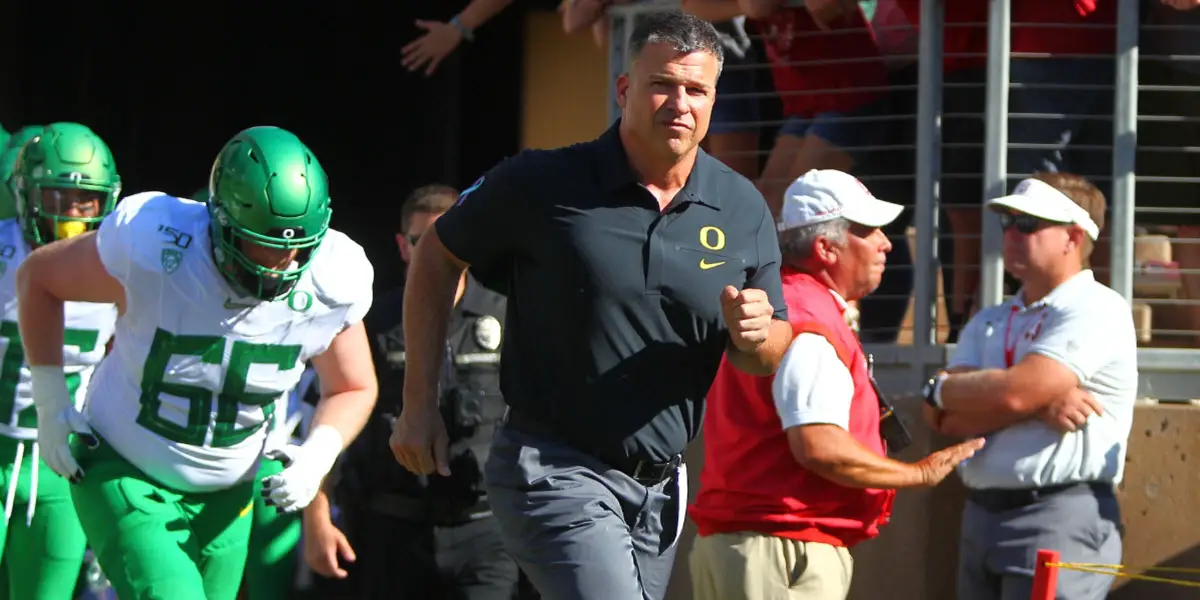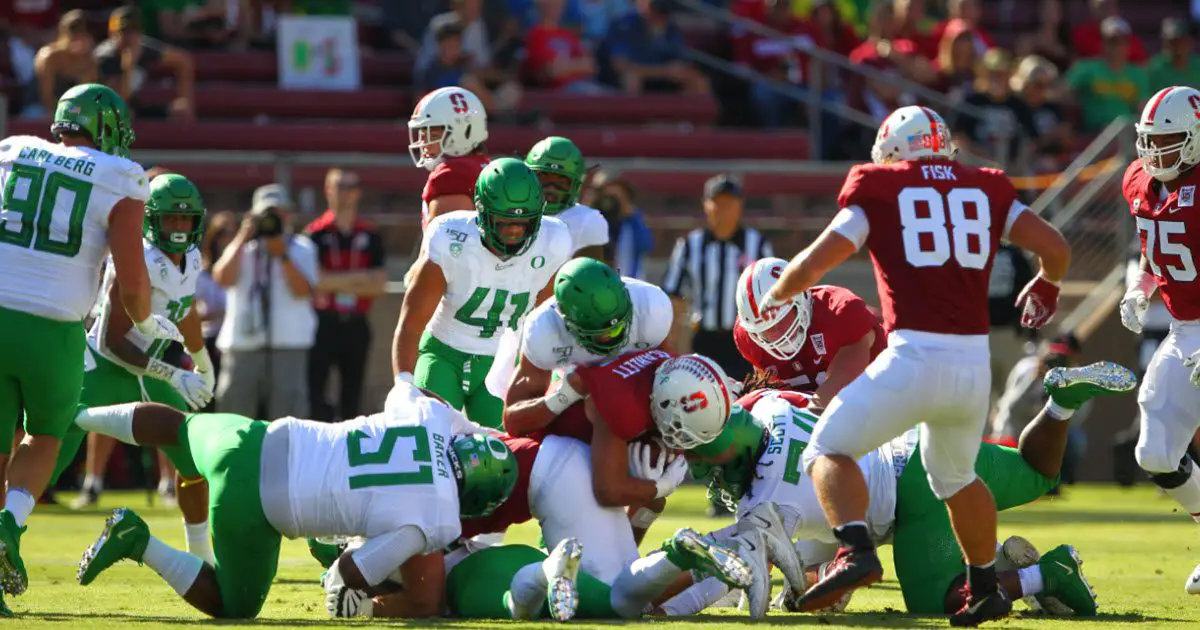Coach Mario Cristobal and Duck fans everywhere enjoyed a measure of revenge for last year’s debacle loss to Stanford with a satisfying 21-6 win over the Cardinal in Palo Alto. Although most would have preferred six or seven touchdowns, three were enough and the defense continued to keep players out of their end zone.
The Ducks had problems blocking on both runs and passes, and all the pre-season talk of dominating other teams and having depth is being severely tested. The running game was bland, and it’s also obvious Cristobal lacks the depth and speed at running back to make Oregon an SEC offense.
On the other hand, having Justin Herbert at quarterback, and being able to count on him completing 70% of his passes, with many going for touchdowns and none intercepted, gives Coach Cristobal a clear idea of what he needs to do: protect his thrower and use more creative play calling to make the most of the speed and athleticism of key skill players.
“Low man wins.” Stanford takes pride in the pad levels of their blockers and defenders, and in this case, Stanford’s pass blocker (above) is being stood up by the Oregon defensive lineman who has leverage with a lower pad level, enabling him to push the blocker back into the face of K.J. Costello. As the game wore on, the Duck defensive front’s pass rush came stronger and tougher for the inexperienced Cardinal front.
Worse, for Stanford, Costello hit his thumb on the helmet of his own blocker and was obviously injured on the play. Although he was able to finish the game, his pass credentials (16-of 30, with 1 interception and 120 yards) were much below his average, and what the Cardinal needed to make the game competitive. Coupled with the lack of explosion run or pass plays — only two longer than 20 yards and none longer than 23, Stanford was a battleship without any ammunition.
After two years of heartbreak and six touchdowns on Alley Ooop jump balls, Duck defensive backs showed excellent technique and physicality in defending a 6-7 receiver in the end zone. Cody Parkinson is Costello’s target on this throw and is defended by cornerback Thomas Graham Jr. (No. 4 above), who uses his body to move Parkinson’s toward the end zone sideline as the ball is coming down. It’s like two basketball players trying to block each other out underneath the basket for a rebound. Graham also can see the ball, so his chances of defending are even better.
Herbert was sacked four times in the game, and Stanford was able to get pressure without having to resort to rushing more than four defenders. In the first example, Calvin Throckmorton (No. 54), normally a tackle but filling in at center for the injured Jake Hanson, is caught up in a stunt where a defensive end from his far right comes all the way around the center to get free over the left guard.
It’s difficult to tell without knowing what is called, (above) but a couple of things jump out: (No. 75) Dallas Warmack is held up and gets his shoulders turned sideways too much. The teamwork between Throckmorton and left guard Shane Lemieux (No. 68) is ineffective; the center can’t be called to pick up that stunt. What probably should have happened is Lemieux should have jolted his rusher, and Throckmorton, getting more depth, would have time and vision to pick up the slanting lineman, leaving Lemieux in better position to pick up the stunting defensive end. Finally, check the pad level of left tackle Penei Sewell (No. 58), who is working hard to keep his pad level lower than the end who is rushing him.
In the second play, Stanford rushes hard off the Ducks’ right side, and the problem here is that the offensive line needed to turn out to its right to pick up the rush, which seems pretty obvious by their pre-snap alignment. The issue is that either Herbert missed a hot read to his running back releasing right, or the line did not adjust its blocking pattern to the defensive alignment by turning to the right.
This is a time when the center or tackle must alert the rest of the line so they are operating as a unit. In some cases, it’s up to the quarterback to have the line change their pass blocking scheme, so Herbert may be the guilty party here.
Protecting Herbert is Job No. 1 right now as he is the “big play” guy for the offense. Mix-ups like this happen when starters are missing from the lineup and backups or players who play other positions must fill in. The offensive line and quarterback desperately need a bye week in order to fix this.
This is a run pass option that ends in a 36-yard touchdown pass to Jaylon Redd, one of several option passes Herbert successfully executed against Stanford (above). In this case, he reads the inside linebacker who reacts to the run read inside, leaving a huge gap for Redd to run through the seam.
The Cardinal secondary did not adjust well to this play, as the safety and outside linebacker both reacted towards the split receivers; there are too many red jerseys going the wrong way on this play. This was Herbert’s 32nd straight game with a scoring pass, which currently leads the NCAA.
CJ Verdell (No. 7 above) is caught from behind on a zone play running to his right. Defenses are not honoring the potential of quarterback Herbert running an option and thus can afford to crash their defensive end (No. 90) hard to the inside, leaving no one to cover an outside play.
Verdell lined up eight yards deep in the Pistol formation, and this play shows a weakness of the alignment: the running back is still two yards from the line of scrimmage when he is tackled from behind. Worse, the Ducks have five blockers who can’t effectively block only four immediate defenders.
Either a reverse or the quarterback running an option would be excellent ways to slow down the immediate reactions of a defense that held the Ducks to only 61 yards on 30 carries, with the longest run only 11 yards.

Mario Cristobal at Stanford
Coach Cristobal managed the game conservatively, but wisely. There are probably a lot of fans who miss the days of 30 and 40-point games, but those are probably gone. What’s in place right now is an excellent quarterback who is efficiently managing the offense and a defense that is improving game by game and has not allowed a touchdown in three straight games. It remains to be seen if three touchdowns per game on offense are all that’s going to be necessary to win the Pac-12 Northern Division.
A bye week comes at a good time; the Ducks need time to heal and smooth some things out, such as pass protection, run blocking, field goal kicking and snapping. The Cal Bears loom ahead in two weeks, and Cristobal and Oregon need to be ready for a tough football game — probably tougher than the Stanford game turned out to be.
Coach Ken Woody
Eugene, Oregon Top Photo by Matt Zlaket
Want to learn from Coach Woody in person? He will be analyzing the prior game each week this season at the 6th Street Grill in Eugene on Wednesdays from 6:00 to 7:30 PM with video analysis and opening it up for questions. Join him and learn more football! Charles Fischer

Natalie Liebhaber, the FishDuck.com Volunteer Editor for this article, works in the financial technology industry in Bozeman, Montana.
Dan Fouts, NFL Hall of Fame, Oregon Ducks quarterback: “Entertaining and easy to understand.”
“Every Oregon fan should have a copy to learn from as I do.” Charles Fischer
Buy the book here to learn from Coach Woody, or give a gift of football, a great gift for the fan who wants to learn and enjoy more of the Duck (or whoever your favorite team is) football experience.
Ken Woody is a former Fox Sports football commentator who played defensive back, receiver and kicker for Oregon from 1966 to 1970. He coached college football for 18 years, including stints as an assistant coach at Oregon, Washington, Washington State and Utah State, and was head coach at Whitman College and Washington University-St. Louis. He writes x’s and o’s, a weekly column in the Register-Guard, RG online coverage of Duck football and is the author of “After Further Review—an inside look at what’s really happening on the football field.” Woody is on KUGN (590 am) 2:45 before kickoff and 30 minutes after each game with coaching and game analysis.
Related Articles:
“I learned football working under many great coaches, among them Len Casanova, Jerry Frei, John Robinson, Bruce Snyder, George Seifert,and Ron Stratten at the University of Oregon, Jim Owens at the University of Washington and Jim Walden at Washington State University. Most of my coaching experience was on the offensive side of the ball with quarterbacks, receivers and kickers although as a head coach I coached defensive backs, linebackers and offensive line.
I achieved my first goal of being the youngest head coach in college football at the age of 26 and throughout my career in coaching and outside of it, as a journalist and broadcaster, have experienced how exciting and gratifying it is teaching the game to others.”



